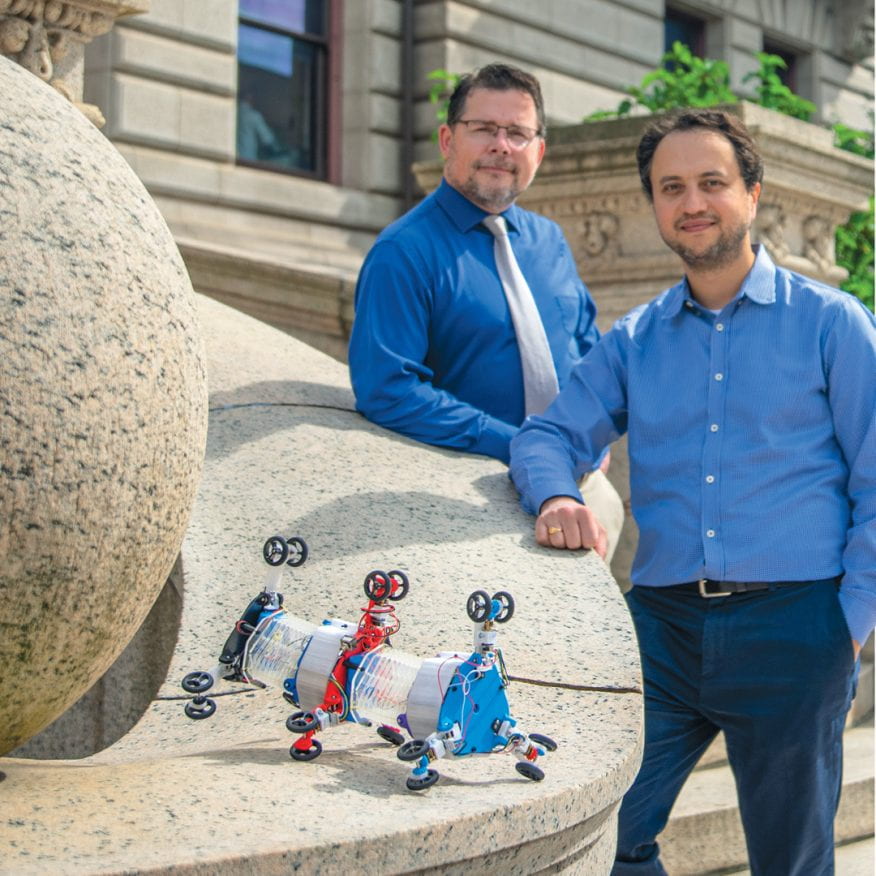A Robotics Resource for Solving Problems
ROSE-HUB bridges the gap between WPI robotics research and the development of commercial technologies.
Read StoryLizard-like robots sneak into small spaces for mapping and inspections.
WPI researchers have developed a lizard-like soft robot that can creep into walls, ductwork, and pipes to perform inspections and 3-D mapping tasks that could be dangerous or impossible for humans. Associate Professor of Robotics Engineering Cagdas Onal, Associate Professor and Director of Sustainability Paul Mathisen, Associate Professor of Anthropology Yunus Telliel, and Assistant Professor of Robotics Engineering Berk Calli collaborated with students and the City of Worcester to design the slender and deformable robot that can get into tight spaces much less invasively than current methods allow. The project was funded by a $50,000 National Science Foundation grant.
Matthew Urban, capital projects manager for the City of Worcester, worked with the WPI team as it developed and tested the robot, providing access to tight spaces in old buildings.
“City Hall is almost 130 years old,” says Urban. “Within the walls, there is plaster, wire mesh, solid masonry, and steel-type construction. Anytime I need to know what’s in this wall, I need to cut a hole. Then I need to see if I can get a camera in there, and it needs to look in the right direction, and maybe it’s not bright enough. Then I need to go cut another hole.” He says the robot promises to go beyond the limitations of current scoping technology and could prove to be a critical tool used to carefully update historic buildings.

Matthew Urban and Cagdas Onal at Worcester City Hall
The team built the prototype robot—an “origami” design made of plastic, 3D-printed and laser-machined parts, custom circuit boards, a miniature computer, sensors, a few metal parts, and motors—and tested it in locations across the city. Due to its size and shape, the prototype robot was able to maneuver into the nooks and crannies of the aging infrastructure to unobtrusively navigate inside the walls, above drop ceilings, and into ductwork. Designed to accommodate cameras and sensors that can measure temperature and contaminant levels, the robot can use artificial intelligence to operate with a level of autonomy, and can map the areas it moves through, collecting important data.
Since its steering and propulsion systems are separate, the robot can deform its body—like a lizard—to get into small spaces. Once inside, it can travel horizontally and even vertically in small spaces. It can navigate maze-like structures without getting stuck, and its modular body structure allows it to use multiple motors to climb over larger steps or gaps, and operate in pipe networks.
If completed and commercialized, the robot could improve worker safety and make cities more sustainable by making it easier to retrofit buildings for climate adaptation.
“Some of these places the robot can get into are not ideal for workers,” says Telliel. “One of our priorities is to design for the safety of people who would be using this robot.” As the social scientist on the team, he says a significant aspect of this project is its potential to present partnerships with the public and civic sector as a motor of innovation in robotics—what he calls “public interest robotics.”
Yunus TellielOne of our priorities is to design for the safety of people who would be using this robot.
Mathisen says that for Worcester and a lot of other cities, energy is a major factor when determining the impact of climate change on a population. The robot could be helpful in determining how best to insulate upper areas of buildings, which are susceptible to high heat and energy losses in colder, winter months, and also concentrated heat during summer heatwaves, he says.
Calli says the robot’s video and three-dimensional mapping capabilities could bridge the gap between what a municipality knows about a building from blueprints and building permits, and what actually exists. Many older buildings lack detailed plans and likely have had modifications done over the years without much documentation.
Onal says the team is developing proposals and is continuing its efforts to further refine the design, conduct more testing, and develop a system that supports municipal employees in their efforts to mitigate the impacts of climate change.
Reader Comments
0 Comments